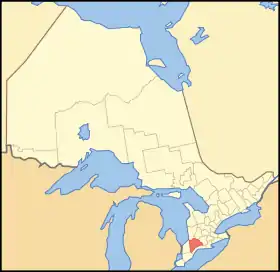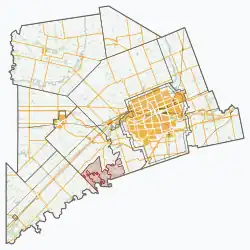Middlesex County | |
|---|---|
| County of Middlesex | |
 Location of Middlesex census division | |
| Coordinates: 43°00′N 81°30′W / 43.000°N 81.500°W | |
| Country | Canada |
| Province | Ontario |
| Named for | Middlesex, England |
| County seat | London |
| Municipalities | |
| Area | |
| • Land | 2,821.00 km2 (1,089.19 sq mi) |
| Population (2016)[1] | |
| • Total | 71,551 |
| • Density | 25.4/km2 (66/sq mi) |
| Time zone | UTC-5 (EST) |
| • Summer (DST) | UTC-4 (EDT) |
| Website | www.middlesex.ca |
Middlesex County (2016 population: 71,551)[1] is a primarily rural county in Southwestern Ontario, Canada. Landlocked, the county is bordered by Huron and Perth counties on the north, Oxford County on the east, Elgin County on the south, and Chatham-Kent and Lambton County on the west.
The county seat is the city of London, although the city is politically independent from the county. The Middlesex census division, which consists of the county together with the City of London and three First Nations reserves, had a population of 455,526 in 2016.[2] Part of the county is also included in the London census metropolitan area.
Administrative divisions
Middlesex County is composed of eight incorporated municipalities (in order of population):
- Strathroy-Caradoc, Township of
- Population centres: Strathroy and Mount Brydges. Other communities: Cairngorm, Campbellvale, Caradoc, Christina, Falconbridge, Glen Oak, Longwood, Melbourne (part) and Muncey.
- Middlesex Centre, Municipality of
- Population centre: Ilderton. Other communities: Arva, Ballymote, Birr, Bryanston, Coldstream, Delaware, Denfield, Duncrief, Elginfield, Ettrick, Ivan, Kilworth, Komoka, Littlewood, Lobo, Lobo Siding, Maple Grove, Melrose, Poplar Hill, Sharon, Southgate, Southwold, Telfer and Vanneck.
- Thames Centre, Municipality of (township)
- Population centres: Dorchester and Thorndale. Other communities: Avon, Belton, Cherry Grove, Crampton, Cobble Hill, Derwent, Devizes, Evelyn, Fanshawe Lake, Friendly Corners, Gladstone, Harrietsville, Kelly Station, Mossley, Nilestown, Oliver, Plover Mills, Putnam, Salmonville, Silvermoon, Three Bridges and Wellburn.
- North Middlesex, Municipality of (township)
- Population centre: Parkhill. Other communities: Ailsa Craig, Beechwood, Bornish, Bowood, Brinsley, Carlisle, Corbett, Greenway, Hungry Hollow, Lieury, Moray, Mount Carmel, Nairn, Sable, Springbank, Sylvan and West McGillivray.
- Southwest Middlesex, Municipality of (township)
- Population centre: Glencoe. Other communities: Appin, Ekfrid, Lewis Corners, Macksville, Mayfair, Melbourne (part), Newbury Station, North Appin Station, North Ekfrid, North Glencoe Station, Riverside, Strathburn, Tate Corners, Wardsville and Woodgreen.
- Lucan Biddulph, Township
- Population centre: Lucan. Other communities: Biddulph, Clandeboye and Granton.
- Adelaide Metcalfe, Township
- Communities: Adelaide, Crathie, Dejong, Kerwood, Keyser, Mullifarry, Napier, Napperton, Springfield, Walkers and Wrightmans Corners.
- Newbury, Village
First Nations reserves located within the Middlesex census division but separate from Middlesex County:
History
The area was originally organized as Suffolk County, created in July 1792 by Governor Simcoe by his first proclamation issued at Kingston, which also defined it as a constituency for the purposes of returning a member to the new Legislative Assembly of Upper Canada, and was described as having the following territory:[3]
... bounded on the east by the county of Norfolk, on the south by lake Erie, until it meets the carrying-place from point au Pins unto the Thames,[4] on the west by the said carrying-place, thence up the said river Thames until it meets the northwesternmost boundary of the county of Norfolk.

Simcoe toured the southwestern portion of the province's territory in early 1793 and concluded that the lower forks of the Thames would be best suited as the future site of the provincial capital. The names London in Middlesex were considered more appropriate for this. Suffolk County was reorganized as Middlesex County, as part of the London District, in 1798 by the Legislative Assembly of Upper Canada,[5] consisting of the townships of London, Westminster, Dorchester, Yarmouth, Southwold, Dunwich, Aldborough and Delaware.

Middlesex County was expanded several times thereafter, starting in 1821 with the addition of the townships of Moza, Ecfrid (sic), Carradoc (sic) and Lobo.[6] Adelaide Township came from the Huron Tract in 1835,[7] and Williams Township was withdrawn from Huron County and annexed to Middlesex in 1845.[8] In 1837, Bayham and Malahide Townships were transferred to Middlesex from Norfolk County.[9] Metcalfe Township was formed from the north part of Ekfrid and the south part of Adelaide in 1845.[10]
Upon the abolition of the London District in January 1850, Middlesex County was constituted for municipal purposes.[11] The County was reorganized as the United Counties of Middlesex and Elgin in 1851, with its townships divided thus:
| Elgin County | Middlesex County |
|---|---|
|
- 1 2 divided in 1851 (1851 Act, Sch. D)
- ↑ separated from Nissouri Township of Oxford County (1851 Act, Sch. D)
Elgin County was separated from Middlesex in September 1853.[13]
The townships of Biddulph and McGillivray were withdrawn from Huron County and annexed to Middlesex in 1862.[14]
The historic townships of the County (including those originally part of Huron County marked in red) are shown below:

Withdrawal and evolution of the City of London

London, when it became a city in 1855, separated from Middlesex County,[15] and it expanded later in stages:
| Year | Community |
|---|---|
| 1885 |
|
| 1890 |
|
| 1897 | |
| 1912[15] |
|
| 1961 |
|
| 1993[19] |
|
- ↑ previously known as Petersville or Kensington
Demographics
As a census division in the 2021 Census of Population conducted by Statistics Canada, Middlesex County had a population of 500,563 living in 204,157 of its 216,736 total private dwellings, a change of 9.9% from its 2016 population of 455,526. With a land area of 3,317.76 km2 (1,280.99 sq mi), it had a population density of 150.9/km2 (390.8/sq mi) in 2021.[20]
Middlesex County has 38,231 people over the age of 15, with 45% of them working in the same municipality as the one they live in.[21] That implies that more than 50% of them commute to other municipalities.
| Year | Pop. | ±% |
|---|---|---|
| 1996 | 64,140 | — |
| 2001 | 66,635 | +3.9% |
| 2006 | 69,032 | +3.6% |
| 2011 | 70,796 | +2.6% |
| 2016 | 71,551 | +1.1% |
| All data from the Census of Canada | ||
Municipal government
Members of the County Council are the mayors (or reeves) of the municipalities of Adelaide Metcalfe, Lucan Biddulph, Middlesex Centre, North Middlesex, Southwest Middlesex, Strathroy-Caradoc and Thames Centre as well as the Village of Newbury. Centres with a population exceeding 5,000 also get an additional seat for their deputy mayors. The head of council is one of its members who is elected as reeve for a one year term by the councillors.[22]
See also
References
- 1 2 3 Sum of the eight municipalities in Middlesex County from "Census Profile". 2016 Census of Population. Statistics Canada. Retrieved 2017-02-08.
- ↑ "Census Profile". 2016 Census of Population. Statistics Canada. Retrieved 2017-02-08.
- ↑ Proclamation of July 16, 1792
- ↑ a portion of which became part of Highway 40 in the 20th Century
- ↑ An act for the better division of this province, S.U.C. 1798, c. 5, s. 36-37
- ↑ An Act to repeal part of an act passed in the thirty-eighth year of his late Majesty's reign, entitled, "An act for the better division of this province," and to make further provision for the division of the same into counties and districts, S.U.C. 1821, c. 3, s. 11
- ↑ An Act to form certain Townships in the London District into a County, and to attach certain Townships to the Counties of Middlesex and Kent, in the London and Western Districts, S.U.C. 1835, c. 46
- ↑ An Act for better defining the limits of the Counties and Districts in Upper Canada, for erecting certain new Townships, for detaching Townships from some Counties and attaching them to others, and for other purposes relative to the division of Upper Canada into Townships, Counties and Districts, S.Prov.C. 1845, c. 7, Sch. B
- ↑ effectively withdrawn upon the passage of An Act to authorise the erection of the County of Oxford into a separate District, by the name of the District of Brock, S.U.C. 1837, c. 30 and An Act erecting the County of Norfolk into a separate District, by the name of the District of Talbot, S.U.C. 1837, c. 33
- ↑ 1845 Act, Sch. A
- ↑ An Act for abolishing the Territorial Division of Upper-Canada into Districts, and for providing temporary Unions of Counties for Judicial and other purposes, and for the future dissolutions of such Unions, as the increase of wealth and population may require, S.Prov.C. 1849, c. 78, Sch. C
- ↑ An Act to make certain alterations in the Territorial Divisions of Upper Canada, S.Prov.C. 1851, c. 5, Sch. A, par. 35-36; Sch. B
- ↑ "Proclamation". Canada Gazette. XII (29): 1452–1453.
- ↑ An Act to separate the Townships of Biddulph and McGillivray from the County of Huron, and to annex the same to the East Riding of the County of Middlesex, S.Prov.C. 1862, c. 28
- 1 2 "Founding of the Forest City". london.ca. July 26, 2016.
- ↑ An Act respecting the City of London and the Town of London East, S.O. 1885, c. 63
- ↑ An Act respecting the City of London, S.O. 1890, c. 89
- ↑ An Act respecting the City of London, S.O. 1898, c. 46
- ↑ London-Middlesex Act, 1992, S.O. 1992, c. 27
- ↑ "Population and dwelling counts: Canada and census divisions". Statistics Canada. February 9, 2022. Retrieved April 2, 2022.
- ↑ "Middlesex Workforce".
- ↑ "Government". Middlesex County.
